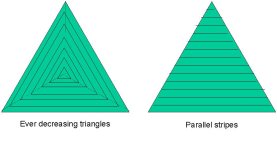Glennmac,
Actually, the equilateral triangle proves the case - that was a great point to raise.
Imagine for a moment the tracks left by the mower if you were to mow in ever decreasing triangles. For any decent size lot (let's say half an acre or more) this will look pretty darned close to a set of triangles fitting inside each other.
Now hold that image of the triangles - decreasing in size - fitting inside each other. Now draw a straight line from each of the three corners of the original triangle to its middle. What do you have? Three smaller triangles that are mowed in parallel stripes. /w3tcompact/icons/cool.gif I've attached a diagram (5 mins in PowerPoint, so not so good) to try and explain.
Actually, the equilateral triangle proves the case - that was a great point to raise.
Imagine for a moment the tracks left by the mower if you were to mow in ever decreasing triangles. For any decent size lot (let's say half an acre or more) this will look pretty darned close to a set of triangles fitting inside each other.
Now hold that image of the triangles - decreasing in size - fitting inside each other. Now draw a straight line from each of the three corners of the original triangle to its middle. What do you have? Three smaller triangles that are mowed in parallel stripes. /w3tcompact/icons/cool.gif I've attached a diagram (5 mins in PowerPoint, so not so good) to try and explain.

